Borneo 2018 Trip Report: Head in the Clouds, Feet in the Mud
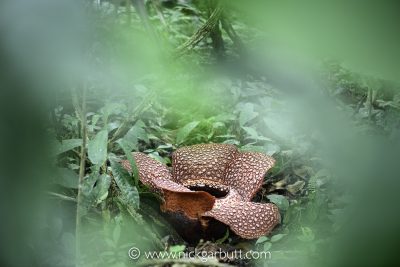
Even though it had only been out for just over 24 hours, this Raffelsia was nearly fully open and proved to be an ideal subject.
Tropical rainforests are my favourite habitat and those that remain in Sabah, Borneo (the ones that have thus far avoided being felled to make way for oil palm) are amongst the very best there are anywhere in the world. I’ve been visiting Borneo now for 30 years and it remains one of my favourite haunts, so I always feel an extra twinge of excitement, when landing in Kota Kinabalu at the start of a new tour. The tour in April / May this year was no different.
Like all the best itineraries, the Borneo trip starts relatively slowly and gradually builds to a crescendo, as we progress from location to location. Our starting point was Mount Kinabalu, where middle elevation forest offers the chance of seeing species that will not be encountered elsewhere on the trip. Mammals are relatively difficult to see, except for various species of squirrel and mountain tree shrews. There are some unusual locally endemic birds, three of which are named after John Whitehead, the Victorian British explorer and ornithologist who was the first to reach the summit of the mountain in 1888. We managed to see both Whitehead’s broadbill and Whitehead’s spiderhunter well, but sightings of Whitehead’s trogon eluded us.
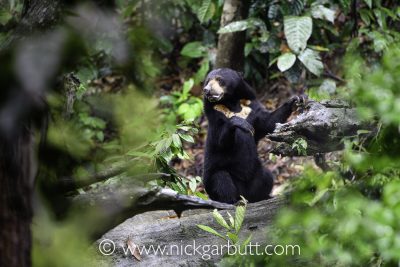
The Bornean Sun Bear Conservation Center is involved with invaluable conservation work and also provides a home and sanctuary for bears that have previously been kept as pets illegally and often in unspeakably hideous conditions.
The best photographic opportunities on Mount Kinabalu are so often with the smaller, less glamorous subjects and the plants. After dark the stream beds and adjacent vegetation are good places to look for various tree frogs, terrestrial frogs and reptiles like the Kinabalu bent-toed gecko.
However, it is perhaps the plants that steal the photographic show, providing luck is with you. This time around it certainly was, although it didn’t at first appear to be so. Having received word there was a Rafflesia in bloom, we decided to delay going to see it for 24 hours, such that we’d see it on its third day after first opening. This is normally the day the bloom is open to its maximum extent and before it begins to show signs of wear and tear. However, hot dry conditions meant decay had set in early, so by the time we arrived on day three the flower was well past its best and partially brown and shrivelled. Frankly it wasn’t worth photographing – a big disappointment. Luckily nearby, a second bloom had emerged overnight and although it was only effectively its first day, the petals had opened almost fully to reveal the splendour of the Rafflesia keithei , which thus provided a far more satisfactory and pleasing subject to photograph.
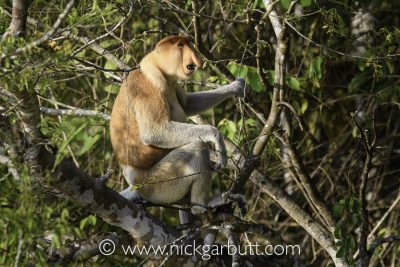
Endemic to Borneo, proboscis monekys are largely confined to riverine and mangrove habitats. They are most often encountered in trees at the water’s edge and viewing them from boats along the Kinabatangan River often provides some terrific photo opportunities.
We then moved on to the eastern side of Sabah for three nights based at Sepilok, famous for the eponymous orang-utan rehabilitation centre, but offering so much more besides. The rehabilitation centre undoubtedly does much good work in looking after orphaned orang-utans and preparing some of them for repatriation to the wild, however, the main centre at visiting times can be rather crowded and commercial. It is the alternative activities on offer that are the real attraction for those willing to spend more time. Nearby is the much under-used Rainforest Discovery Centre (RDC) that offers the chance to explore primary forest on the edge of the Sepilok reserve. The highlight is an impressive canopy walkway, that at first light is a great place to bird watch and look for several species of primate and various squirrels and flying squirrels. We were able to make two early morning visits and were rewarded with excellent views of pig-tailed and long-tailed macaques, giant squirrel and giant flying squirrel and a good selections of birds.
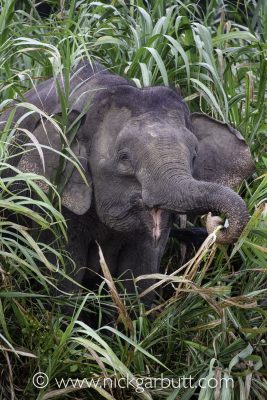
Bornean pygmy elephant feeding at the river’s edge.
Just opposite the Orang-utan Rehabilitation Centre is the recently created Bornean Sun Bear Conservation Centre, which is also well worth visiting. Not only are they involved with invaluable conservation work relating to sun bears in the wild – the world’s smallest species of bear – but the facility also provides a home and sanctuary for bears that have previously been kept as pets illegally and often in unspeakably hideous conditions. The care they receive and large outdoor enclosures certainly improve the quality of life for these bears immeasurably, even to the point that some can be released back to the wild. Some individuals have been too traumatised to allow this, but these then give visitors a chance to observe a fascinating species, that is extremely difficult to see in the wild, in semi-natural surroundings.
The Kinabatangan is arguably the most diverse wildlife area in South East Asia, albeit one that has been altered and compromised by human intervention. Today it is a mosaic of natural habitat – mainly riverine and mangrove forest – and extensive oil palm plantations. The latter environment dominates the area and the natural forest patches and connecting corridors of forest form but a fraction of the overall. Nonetheless, the area remains extremely biodiverse and rich in numerous iconic species. Two locations on the Kinabatangan River, really got us into the ‘meat’ of the tour.
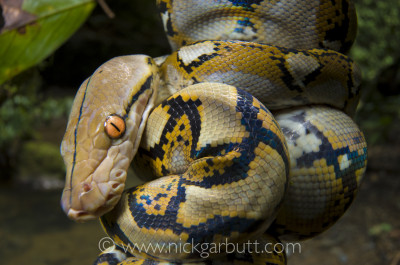
A juvenile reticulated python proved to be a very popular subject for a photo session at Abai Lodge.
Abi Lodge is located in the lower reaches of the Kinabatangan, close to the ecotone where the downstream riverine forests give way to mangroves. The proximity of these two habitat types and an ox-bow lake within the riverine forest, maximises the likely diversity of wildlife on show. Our first trip out on the river backed this up with numerous sightings of troops of proboscis monkeys and long-tailed macaques as well as silvered langurs and pig-tailed macaques. There was also very restricted views of a female orang-utan tucked into her nest.
An additional benefit of Abai Lodge is an extensive raised boardwalk at the rear of the lodge, that winds through a mosaic of riverine forest. Walks around it regularly serve up excellent sightings of any number of species, both during the day and after dark. Night walks are often good for frogs and sometimes snakes, various owls and there is always the chance of seeing something a bit more unusual like a nocturnal primate.
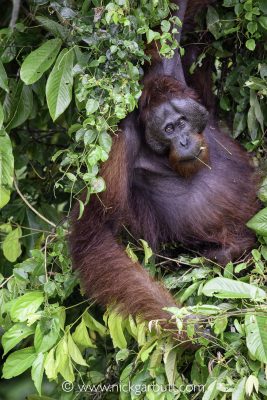
This wonderful flanged male orang-utan was encountered right by the water’s edge on the Kinabatangan near Sukau.
Over the three days we spent at Abai we were able to spend prolonged periods on the main river and some of the smaller tributaries, one of which leads into a large ox-bow lake. The forests around the lake proved good for primate sightings with species like silvered langurs, pig-tailed macaques and long-tailed macaques seen repeatedly. There was also one sighting of maroon langurs or red leaf monkeys, a species seen far less frequently along the Kinabatangan. The best proboscis monkey sightings were always along the main river, both upstream and downstream of the lodge and there were also a couple of distant sightings of orang-utans.
We then transferred upstream to to the Riverside Lodge at Sukau, a trip of around 90 minutes. On the way we managed our first sighting of pygmy elephants – a small group feeding at the water’s edge and then wading through the margins of the river. Once based at the lodge we had two days to explore areas much further upstream on the Kinabatangan. This proved to be excellent for two larger groups of pygmy elephants, numerous groups of proboscis monkeys and on one occasion a fabulous encounter with a huge flanged male orang-utan. Near Sukau is the a tributary called the Menanggol River that is normally excellent for all manner of sightings, although during our trips up it this time around it seemed unusually subdued. There were good sightings go buffy fish owls after dark.
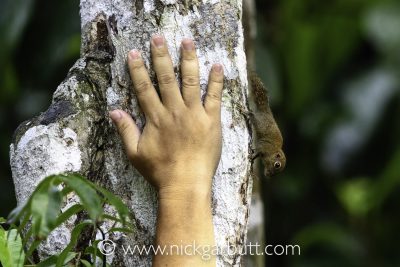
From giant squirrels to pygmy squirrels, Borneo has the extremes and all sizes in between. But just how small is a pygmy squirrel? Here is the answer – barely half the size of an adult hand.
After leaving Sukau we made the usual stop at Gomantong Caves en route to Lahad Datu and then our final location – saving the best until last – Borneo Rainforest Lodge in Danum Valley. I’d be hard pushed to think of any single wildlife location on earth that I hold in higher regard. It really does have everything you’d wish for from a tropical rainforest; diverse and very accessible wildlife, with new and exciting sightings almost a daily occurrence, a canopy walkway, super night walks and a fabulous lodge. Hence finishing the tour with six nights in Danum.
It is one of the best places on Borneo to see genuinely wild orang-utans and this aspect was certainly one of the main highlights of our stay. We enjoyed numerous and repeated sightings of females with babies and huge flanged males at close quarters and all a relatively short walk from the lodge. There were also fabulous intimate encounters with troops of red leaf monkeys (maroon langurs) that are totally habituated and are happy to play in branches and on the forest floor within touching distance.
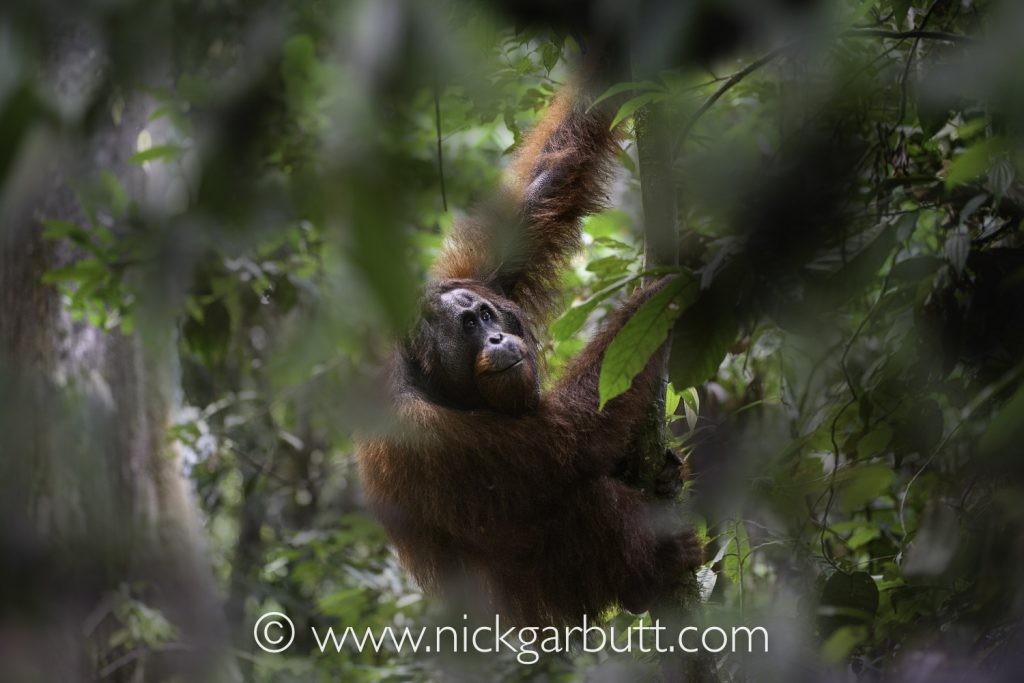
A magnificent dominant flanged male orang-utan in Danum Valley

Young Sumatran pit viper photographed with a fisheye lens
Hornbill activity was also good during our stay. Not only were rhinoceros hornbills active and readily seen, but several fruiting trees had also brought at least three male helmeted hornbills into the area and they were seen several times. These fruiting trees also proved to be very popular with the orang-utans and gibbons.
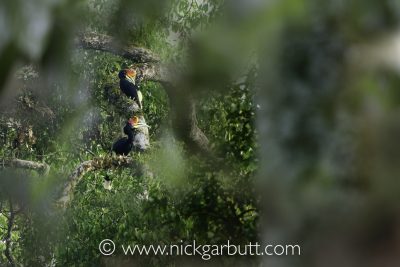
A pair of rhinoceros hornbills in the rainforest canopy in Danum
One of the great joys of Danum is being able to walk straight out of the lodge and start finding interesting things to photograph immediately in the forests adjacent too and surrounding the lodge. This time around there were good photo sessions with male three-horned rhinoceros beetles, Sumatran pit vipers and various species of frogs.
I’m always sad to leave Danum Valley, because few places make me feel more alive. But this feeling is tempered as I know I’m fortunate in having the opportunity to return. My next trip to Danum and Borneo will be in October 2020 for a photography workshop that I’m running with friend and top macro photographer Alex Hyde. Details are currently being finalised, but if you would like to register interest please get in touch – click here.
